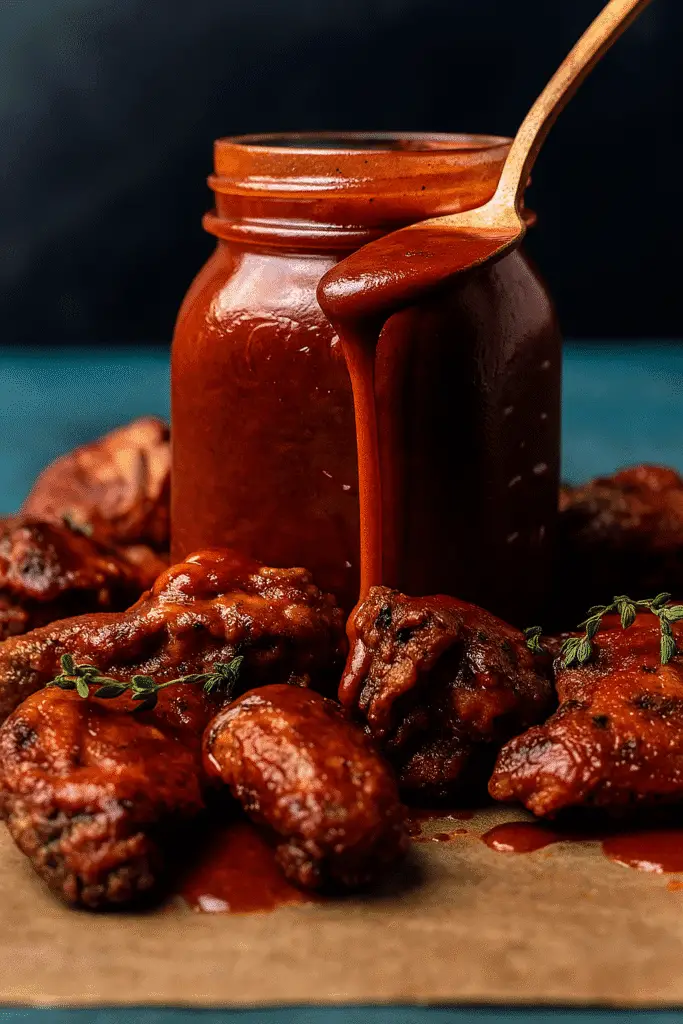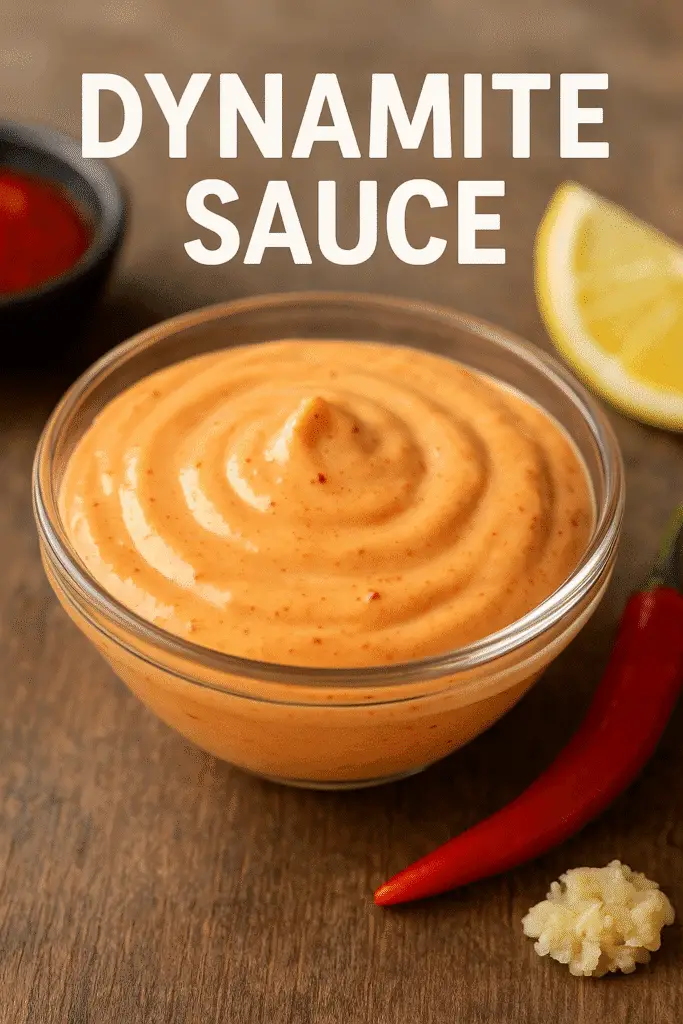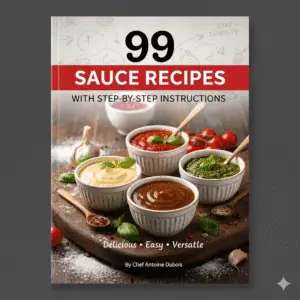I. Introduction
Every great meal—from simple chicken and rice to a plate of gourmet street tacos—is only as good as the flavors that tie it together. Too often, we focus entirely on the main protein or side dish, forgetting the true magic: the sauce. A perfectly crafted sauce is a potent flavor transformer; it’s what turns dull ingredients into a gourmet experience. It provides the essential moisture, complexity, and punch that makes a dish memorable.
If you’ve been relying on crowded, high-sodium, high-sugar bottles from the grocery shelf, you’re missing out. This guide will show you why homemade is unequivocally superior: you gain complete control over every ingredient, guaranteeing maximum freshness while drastically lowering the sodium, preservatives, and processed sugars that commercial brands rely on.
In this comprehensive guide, we’ll master the Four Pillars of Flavor—four essential sauce categories that will build your culinary confidence and allow you to create your own signature condiments:
- The Smoky BBQ Foundation: Achieving deep, savory glaze and tangy finish.
- The Creamy & Fiery Dip: Mastering the art of the stable, delicious emulsion.
- The Fresh & Acidic Kick: Crafting vibrant, preservative-free hot sauces.
- The Sweet & Umami Glaze: Quick pan sauces that balance salty and sweet.
(Image Description: A composite visual showcasing four distinct sauces: a vibrant green hot sauce in a small bottle, a glossy dark red BBQ sauce being brushed onto meat, a creamy orange Dynamite Sauce in a dipping bowl, and a light amber Honey Garlic Sauce drizzled over a piece of chicken. with recipe comment)
II. Pillar 1: The Smoky & Tangy Foundation — Mastery of BBQ Sauce

A great BBQ sauce is arguably the most essential condiment in the world, embodying the perfect marriage of sweet, smoky, and tangy. But not all BBQ sauces are created equal. The diversity of regional styles—from the mustard-based Carolina Gold to the thick, tomato-forward Kansas City style—demonstrates that the foundation is all about balance.
The science behind BBQ sauce is simple but powerful: we use acid (vinegar) to cut through the richness and provide tang, sugar to sweeten and provide the sticky glaze as it caramelizes, and a thick base (often tomato) to provide body. By controlling these elements, you can skip the artificial smoke and high fructose corn syrup of commercial products.
Featured Recipe: Smoky Chipotle BBQ Blast
This recipe is fast, deep in flavor, and perfect for ribs, chicken, or tofu.
Ingredients:
- 1 (6 oz) can tomato paste
- 1 cup water
cup apple cider vinegar
cup brown sugar
- 2 tablespoons molasses
- 1 tablespoon Worcestershire sauce
- 1 tablespoon Dijon mustard
- 1 teaspoon onion powder
- 1 teaspoon garlic powder
- 1-2 Chipotle peppers in adobo sauce, minced (add more for extra heat/smoke)
teaspoon salt
Instructions: Combine all ingredients in a medium saucepan. Bring to a simmer over medium heat, then reduce the heat to low and simmer gently, uncovered, for 25 to 35 minutes, stirring occasionally, until the sauce has thickened and reduced to your desired consistency. Remove from heat and cool completely. The sauce will thicken further as it cools.
Ingredient Deep Dive
- The role of Chipotle in Adobo: This is your secret weapon. Chipotle peppers are smoked, dried jalapeños. By using the peppers and the thick sauce they are packed in, you instantly infuse your BBQ sauce with a genuine, deep smoke flavor without needing a smoker or artificial liquid smoke.
- How acid (Apple Cider Vinegar) cuts through richness: Vinegar is essential. Its high acidity prevents the sauce from tasting heavy or cloyingly sweet. Apple cider vinegar is preferred here for its slightly fruity, mellow flavor that complements the smoke better than plain white vinegar.
- Why tomato paste provides necessary body and richness: While tomato purée is often used, tomato paste is a highly concentrated form. It requires simmering with water, allowing the flavor to develop a rich, savory depth while instantly providing the necessary body and deep color.
Advanced Techniques & Troubleshooting
- Tip: Preventing sugar from burning: BBQ sauce is high in sugar, which can burn easily, especially at high temperatures. To achieve a perfect glaze, do not brush the sauce on meat until the final 10–15 minutes of grilling or baking. This allows the sugars to caramelize without turning black and bitter.
- Variation: Converting to a Bourbon-Chipotle Glaze: For a sophisticated finish, add 2 tablespoons of good quality bourbon during the initial simmer phase. The alcohol will cook off, leaving behind the rich, complex vanilla and oak notes of the bourbon, adding another layer of depth.
- Storage: Store in an airtight container in the refrigerator for up to 2 weeks. For longer storage, properly canning the sauce will extend its shelf life dramatically.
Culinary Applications
Use your homemade sauce for classic favorites like slow-cooked ribs and pulled pork, or try making Smoky Chipotle BBQ Tofu Steaks for a vegetarian feast.
Ready to explore another region? Learn how to make a classic low-country mustard sauce with our guide to [Carolina Gold BBQ Sauce].
III. Pillar 2: The Creamy & Fiery Dip — The Art of Emulsion

Sauces don’t always need hours of simmering to achieve greatness. Sometimes, the best condiments are simple, quick unions of ingredients that elevate everyday foods. The Spicy Mayo, or Dynamite Sauce, is a prime example. While it has become a staple across North America, its origins are Japanese-inspired, often used in sushi rolls and alongside tempura to add a creamy, salty, and spicy dimension. It’s a versatile, high-impact condiment that relies entirely on mastering the stable fat emulsion that is mayonnaise.
Featured Recipe Concept: Dynamite Sauce
This recipe is simple: it’s all about high-quality ingredients and a good whisk.
Core Method: In a small bowl, whisk together the mayonnaise base, heat source, and acid until completely smooth and consistent in color. Chill for at least 30 minutes to allow the flavors to meld.
Ingredients:
cup high-quality Mayonnaise
- 2–3 tablespoons Sriracha (adjust to heat preference)
- 1 tablespoon fresh Lemon Juice
teaspoon garlic powder or finely minced fresh garlic
Ingredient Deep Dive
- The structure of mayonnaise (fat emulsion): Mayonnaise is a culinary marvel—an emulsion of oil and water, stabilized by egg yolk (the emulsifier). This structure creates its characteristic creamy, velvety texture. Because it’s so stable, it acts as a perfect base for suspending other flavors.
- How acid (lemon juice) provides stability and brightness: Adding a small amount of acid, like lemon or lime juice, not only cuts through the richness of the mayo to provide essential brightness and tang, but also helps to reinforce the stability of the emulsion, keeping the oil and water bonded even when other ingredients are introduced.
- Choosing your heat source: You have options beyond the classic Sriracha (which provides a simple, clean chili heat). Try Gochujang for a deep, fermented, subtly sweet heat, or a purée of the Chipotle in Adobo from the previous section for a creamy, smoky kick.
Advanced Techniques & Troubleshooting
- Making it lighter: To reduce the fat and calorie content, substitute half of the mayonnaise with a thick, high-protein base like Greek yogurt or a blended cashew cream. Be aware that this will reduce the stability and shelf life.
- Making it vegan: Swap the standard mayonnaise for a high-quality, oil-based vegan mayo. The flavor and texture will be nearly identical, offering a delicious plant-based option.
- Troubleshooting: What to do if the sauce separates: If you notice small pockets of oil or water forming (a broken emulsion), the easiest fix is to simply whisk in 1 teaspoon of hot water or fresh lemon juice. This often re-introduces enough liquid to help the fat globules reform into a stable emulsion.
Culinary Applications
Dynamite sauce shines when paired with crunchy or savory fried foods: use it for sushi rolls, drizzle over shrimp tempura, serve as a dipping sauce for fries, or slather it onto a spicy chicken or tuna sandwich.
For a deeper dive into the exact ratios and steps for maximum creaminess, link to the full recipe page: [Dynamite Sauce: The Spicy & Creamy Condiment You Need to Try].
IV. Pillar 3: The Fresh & Acidic Kick — Homemade Hot Sauce

Hot sauce is the ultimate expression of vibrant, clean flavor and powerful heat. Creating your own is a rewarding process that yields a condiment far brighter and fresher than anything store-bought. The key to a great hot sauce is vinegar—it is the vital element that defines the texture, provides the necessary tangy counterpoint to the heat, and, most importantly, lowers the pH for natural preservation.
We are focusing here on the quick-simmer sauce—a fast, delicious option where the peppers, aromatics, and vinegar are cooked briefly before being blended and strained. This is distinct from the more complex, deep flavors of long-fermented hot sauces, which require days or weeks.
Featured Recipe Concept: Easy Jalapeño Hot Sauce
This is a versatile, mid-heat hot sauce that is perfect for beginners.
Core Method: Sauté the aromatics and peppers, simmer with vinegar and water until soft, then blend, season, and strain.
Ingredients:
- 1 cup chopped Jalapeños (stems removed)
- 1 cup White Vinegar
cup water
small Onion, roughly chopped
- 3 cloves Garlic, peeled
- 1 teaspoon Salt
teaspoon Sugar
Ingredient Deep Dive
- Controlling heat: The importance of the placenta: The heat in chili peppers comes from capsaicin, which is highly concentrated in the placenta—the white pith or membrane inside the pepper, not the seeds themselves. To reduce heat, carefully scrape out the placenta before cooking. To maximize heat, leave it all in.
- Why sugar is essential: Even in a savory hot sauce, a small amount of sugar (or honey/agave) is critical. It doesn’t necessarily make the sauce sweet, but it is necessary for balancing vinegar’s sharpness. It rounds out the flavor profile and prevents the sauce from tasting harsh or one-dimensional.
- The difference between white vinegar and Apple Cider Vinegar in hot sauce: White vinegar is pure and sharp, offering a clean backdrop that allows the pepper flavor to shine through. Apple Cider Vinegar is fruitier and milder, adding complexity that pairs particularly well with tropical fruit variations.
Advanced Techniques & Troubleshooting
- Technique: Straining for a commercial-quality, pourable consistency: After blending, the resulting purée contains the solids (called the pomace). For a thin, pourable, commercial-quality texture, push the mixture through a fine-mesh sieve or a cheesecloth-lined strainer, removing the pomace. This results in a cleaner sauce.
- Troubleshooting: Thinning or thickening a finished sauce: If your sauce is too thick, simply whisk in more hot water or vinegar until you reach the desired consistency. If it’s too thin, return it to the saucepan and gently simmer for 5–10 minutes to allow the water to evaporate, thickening the sauce through reduction.
- Variation: Adding tropical fruit: For a milder, more flavorful heat, add
cup of chopped pineapple or mango to the simmering pot. The fruit’s sugars ferment slightly with the vinegar and chili, creating a beautifully complex, tropical finish.
Culinary Applications
Hot sauce is arguably the most versatile condiment: douse it on tacos, drizzle over eggs and hash browns, spice up your pizza, or use it as the acid component in quick marinades for vegetables or proteins.
For the exact measurements, simmering times, and advice on preserving your batch, link to the full recipe and in-depth guide: [Make the Best Homemade Hot Sauce: Quick Jalapeño Recipe].
V. Pillar 4: The Sweet & Umami Glaze — Quick Pan Sauces

In the kitchen, sometimes the fastest sauces are the best. Pan sauces and glazes represent some of the quickest ways to create maximum flavor, drawing inspiration from both classic Asian stir-fry techniques and Western bistro cooking (where the “fond,” or browned bits, is scraped up to make a sauce). The fundamental principle here is reduction: simmering liquids to allow water to evaporate, which concentrates flavors and naturally creates a thick, syrupy glaze. This focus on concentrated flavor is what makes glazes so potent, pairing sweet elements with savory, umami notes.
Featured Recipe Concept: Spicy Honey Garlic Dipping Sauce
This recipe hits all the essential flavor notes: sweet, savory, and a clean tang.
Core Method: Whisk all ingredients together, bring to a simmer, and allow to reduce slightly until it coats the back of a spoon.
Ingredients:
cup Honey
cup Soy Sauce (or Tamari for gluten-free)
- 2 tablespoons Rice Vinegar
- 1 tablespoon Sriracha (or chili paste)
- 2 cloves Garlic, minced
teaspoon fresh Ginger, grated
Ingredient Deep Dive
- The synergy of Honey + Soy Sauce (Sweet + Umami): This combination is the heart of the glaze. Honey provides sweetness and body, while the fermented soy sauce provides deep, savory, complex umami—the fifth taste. Together, they create a balanced flavor profile that is addictive.
- The role of Rice Vinegar for a bright, clean finish: Unlike the heavier vinegars used in BBQ, rice vinegar is light and slightly sweet. It provides a clean, necessary acidic foil that prevents the glaze from feeling heavy or overly sweet, leaving a bright finish on the palate.
Advanced Techniques & Troubleshooting
- Technique: Using a cornstarch slurry for quick thickening: While reduction is the ideal method for concentrating flavor, if you are short on time and need to thicken the sauce quickly, create a cornstarch slurry (1 teaspoon of cornstarch mixed with 2 teaspoons of cold water). Whisk this into the simmering sauce and cook for 30 seconds.
- Tip: Using this as a finishing glaze: Glazes are high in sugar and prone to burning. To maximize the glossy shine and prevent scorching, use this sauce as a finishing glaze by tossing your wings, shrimp, or salmon in the sauce after they are fully cooked and removed from the direct heat.
- Variation: Adding peanut butter for a quick Thai-style sauce: For an instant shift in flavor profile, whisk in 1–2 tablespoons of smooth peanut butter (or almond butter) off the heat. This creates a nutty, creamy, complex sauce perfect for noodles or dipping skewers.
Culinary Applications
This glaze is incredibly versatile: use it as a dipping sauce for dumplings and spring rolls, a coating for chicken wings or salmon, or toss it with hot pasta or noodles for a quick, flavorful dinner.
For a detailed breakdown on the best dipping consistency and scaling the recipe, link to the fast, easy recipe: [Spicy Honey Garlic Dipping Sauce Easy Recipe].
VI. Conclusion & Next Steps
Congratulations! You have successfully mastered the four foundational flavor pillars of homemade condiments. You now possess the skills to create a powerful flavor arsenal—from the Smoky BBQ foundation and the Creamy Dynamite emulsion, to the Fresh Hot Sauce kick and the Sweet Umami Glaze.
By taking control of these essential recipes, you unlock dishes that are healthier, fresher, and bursting with a depth of flavor that store-bought bottles simply can’t deliver. The true joy of the kitchen lies in experimentation. Now that you have the fundamentals, we encourage you to start mixing and matching—add mango to your hot sauce, bourbon to your glaze, or gochujang to your dynamite dip. Create your own signature sauces!
Ready to expand your homemade flavor skills beyond the bottle? Explore our related content on perfecting vinaigrettes, building complex marinades, and creating rich, slow-cooked stews and braises. The adventure continues!


